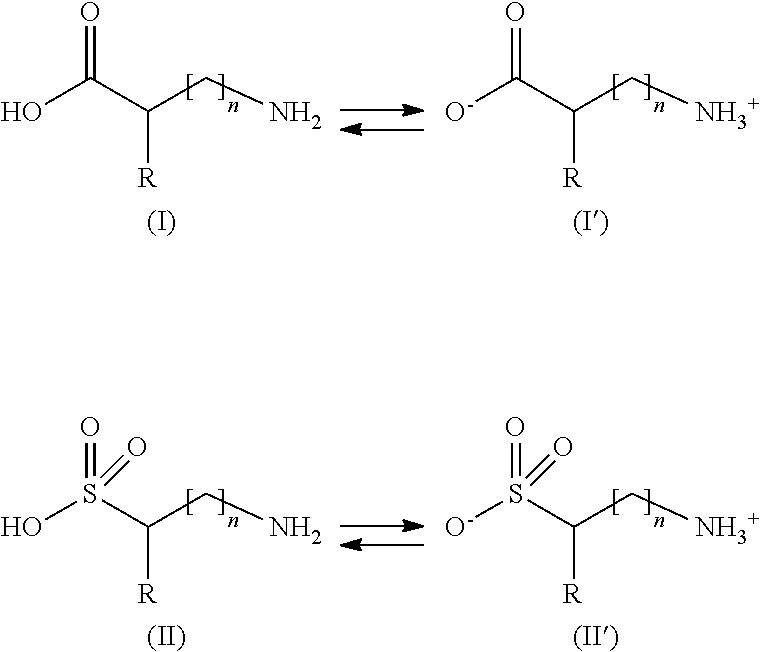Hair-treatment compositions
a hair treatment and composition technology, applied in the field of hair treatment compositions, can solve the problems of hair damage that significantly weakens and dulls hair, hair is more difficult to comb and style, dry hair that has been weakened or damaged is also prone to breakage, and the formation of “split ends"
- Summary
- Abstract
- Description
- Claims
- Application Information
AI Technical Summary
Benefits of technology
Problems solved by technology
Method used
Image
Examples
example 1
Sulfate Shampoos
[0508]
INCI US#1#2#3#4#5#6ActiveTAURINE333333ActiveCITRIC ACID3333ActiveTRIETHANOLAMINE5AnionicSODIUM LAURETH11.21515151511.2Surfactant(s)SULFATE AND / OR SODIUMLAURYL SULFATEWater-SolubleHEXYLENE GLYCOL0.50.5CarrierAmphotericCOCAMIDOPROPYL2.42.4SurfactantBETAINEFatty CompoundGLYCOL DISTEARATE1.51.51.51.5SiliconeDIMETHICONE0.80.80.80.8Cationic PolymerGUAR HYDROXYPROPYL-0.50.20.20.20.20.5TRIMONIUM CHLORIDEAND / ORPOLYQUATERNIUM-10PreservativesOPTIONAL COMPONENT0-20-20-20-20-20-2Salt(s)OPTIONAL COMPONENT0-20-20-20-20-20-2NonionicOPTIONAL COMPONENT0-50-50-50-50-50-5Surfacrant(s)Thickener(s)OPTIONAL COMPONENT0-20-20-20-20-20-2pH Modifier(s)OPTIONAL COMPONENT0-30-30-30-30-30-3Fragrance(s)OPTIONAL COMPONENT0-30-30-30-30-30-3WaterWATERQ.S.Q.S.Q.S.Q.S.Q.S.Q.S.
example 2
[0509]
INCI US#7ActiveTAURINE3ActiveCITRIC ACID3ActivePIROCTONE OLAMINE0.1AnionicSODIUM LAUROYL SARCOSINATE,10.4Surfactant(s)SODIUM LAURYL SULFOACETATE,DISODIUM LAURETHSULFOSUCCINATE, AND / ORSODIUM COCOYL ISETHIONATEAmphotericCOCO-BETAINE4.5SurfactantNonionicDECYL GLUCOSIDE AND / OR1Surfactant(s)TRIDECETH-6 AND / OR PPG-5-CETETH-20SiliconeAMODIMETHICONE0.6Cationic PolymerPOLYQUATERNIUM-100.6Water-Soluble CarrierPROPYLENE GLYCOL0.2Fatty Compound(s)GLYCOL DISTEARATE AND / OR1.6PEG-55 PROPYLENE GLYCOLOLEATEPreservative(s)OPTIONAL COMPONENT0-2Salt(s)OPTIONAL COMPONENT0-2Thickener(s)OPTIONAL COMPONENT0-2pH Modifier(s)OPTIONAL COMPONENT0-3Fragrance(s)OPTIONAL COMPONENT0-3WaterWATERQ.S
example 3
Anionic Surfactant-Free Conditioning Shampoos
[0510]
INCI US#8#9ActiveTAURINE33ActiveCITRIC ACID1.5AmphotericSODIUM55SurfactantCOCOAMPHOPROPIONATECationicBEHENTRIMONIUM CHLORIDE3.23.2SurfactantWater-SolubleCAPRYLYL GLYCOL,1.81.8Solvent(s)GLYCERIN AND / ORISOPROPYL ALCOHOLThickenerHYDROXYPROPYL STARCH3.53.5PHOSPHATEFatty Compound(s)CETEARYL ALCOHOL AND / OR6.16.1SOYBEAN OILUV FilterETHYLHEXYL0-10-1METHOXYCINNAMATEPreservative(s)OPTIONAL COMPONENT0-20-2pH Modifier(s)OPTIONAL COMPONENT0-30-3Fragrance(s)OPTIONAL COMPONENT0-30-3WaterWATERQ.SQ.S.
PUM
| Property | Measurement | Unit |
|---|---|---|
| wt. % | aaaaa | aaaaa |
| wt. % | aaaaa | aaaaa |
| wt. % | aaaaa | aaaaa |
Abstract
Description
Claims
Application Information
 Login to View More
Login to View More - R&D
- Intellectual Property
- Life Sciences
- Materials
- Tech Scout
- Unparalleled Data Quality
- Higher Quality Content
- 60% Fewer Hallucinations
Browse by: Latest US Patents, China's latest patents, Technical Efficacy Thesaurus, Application Domain, Technology Topic, Popular Technical Reports.
© 2025 PatSnap. All rights reserved.Legal|Privacy policy|Modern Slavery Act Transparency Statement|Sitemap|About US| Contact US: help@patsnap.com



